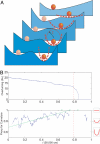Tipping elements in the Earth's climate system
- PMID: 18258748
- PMCID: PMC2538841
- DOI: 10.1073/pnas.0705414105
Tipping elements in the Earth's climate system
Abstract
The term "tipping point" commonly refers to a critical threshold at which a tiny perturbation can qualitatively alter the state or development of a system. Here we introduce the term "tipping element" to describe large-scale components of the Earth system that may pass a tipping point. We critically evaluate potential policy-relevant tipping elements in the climate system under anthropogenic forcing, drawing on the pertinent literature and a recent international workshop to compile a short list, and we assess where their tipping points lie. An expert elicitation is used to help rank their sensitivity to global warming and the uncertainty about the underlying physical mechanisms. Then we explain how, in principle, early warning systems could be established to detect the proximity of some tipping points.
Conflict of interest statement
The authors declare no conflict of interest.
Figures


Similar articles
-
Social tipping dynamics for stabilizing Earth's climate by 2050.Proc Natl Acad Sci U S A. 2020 Feb 4;117(5):2354-2365. doi: 10.1073/pnas.1900577117. Epub 2020 Jan 21. Proc Natl Acad Sci U S A. 2020. PMID: 31964839 Free PMC article.
-
Exceeding 1.5°C global warming could trigger multiple climate tipping points.Science. 2022 Sep 9;377(6611):eabn7950. doi: 10.1126/science.abn7950. Epub 2022 Sep 9. Science. 2022. PMID: 36074831
-
Overshooting tipping point thresholds in a changing climate.Nature. 2021 Apr;592(7855):517-523. doi: 10.1038/s41586-021-03263-2. Epub 2021 Apr 21. Nature. 2021. PMID: 33883733 Review.
-
Using GENIE to study a tipping point in the climate system.Philos Trans A Math Phys Eng Sci. 2009 Mar 13;367(1890):871-84. doi: 10.1098/rsta.2008.0171. Philos Trans A Math Phys Eng Sci. 2009. PMID: 19087945
-
Remotely sensing potential climate change tipping points across scales.Nat Commun. 2024 Jan 6;15(1):343. doi: 10.1038/s41467-023-44609-w. Nat Commun. 2024. PMID: 38184618 Free PMC article. Review.
Cited by
-
Response of atmospheric pCO to a strong AMOC weakening under low and high emission scenarios.Clim Dyn. 2024;62(8):7559-7574. doi: 10.1007/s00382-024-07295-y. Epub 2024 Jun 6. Clim Dyn. 2024. PMID: 39534654 Free PMC article.
-
Perspectives on the quality of climate information for adaptation decision support.Clim Change. 2024;177(11):163. doi: 10.1007/s10584-024-03823-1. Epub 2024 Nov 5. Clim Change. 2024. PMID: 39513176 Free PMC article.
-
Cooperative control of environmental extremes by artificial intelligent agents.J R Soc Interface. 2024 Nov;21(220):20240344. doi: 10.1098/rsif.2024.0344. Epub 2024 Nov 6. J R Soc Interface. 2024. PMID: 39501770
-
The climate change-pollution-aerobiome nexus: A 'systems thinking' mini-review.Microb Biotechnol. 2024 Oct;17(10):e70018. doi: 10.1111/1751-7915.70018. Microb Biotechnol. 2024. PMID: 39401032 Free PMC article. Review.
-
Boreal tree species diversity increases with global warming but is reversed by extremes.Nat Plants. 2024 Oct;10(10):1473-1483. doi: 10.1038/s41477-024-01794-w. Epub 2024 Sep 11. Nat Plants. 2024. PMID: 39261713 Free PMC article.
References
-
- Rahmstorf S, Ganopolski A. Clim Change. 1999;43:353–367.
-
- Cox PM, Betts RA, Jones CD, Spall SA, Totterdell IJ. Nature. 2000;408:184–187. - PubMed
-
- Huybrechts P, De Wolde J. J Clim. 1999;12:2169–2188.
-
- Gladwell M. The Tipping Point: How Little Things Can Make a Big Difference. New York: Little Brown; 2000.
-
- Schellnhuber H-J, Held H. In: Managing the Earth: The Eleventh Linacre Lectures. Briden J, Downing T, editors. Oxford: Oxford Univ Press; 2002. pp. 5–34.
LinkOut - more resources
Full Text Sources
Other Literature Sources


